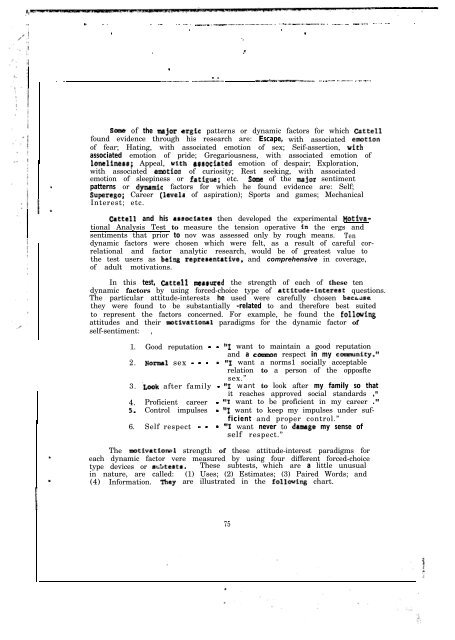Technical Report - International Military Testing Association
Technical Report - International Military Testing Association
Technical Report - International Military Testing Association
You also want an ePaper? Increase the reach of your titles
YUMPU automatically turns print PDFs into web optimized ePapers that Google loves.
-. _- _. ._. ,. _ -- _ ______-________ ---..--- ..-_--_--___. .--..- ----.. -... -- .<br />
. *<br />
. .<br />
& .’<br />
.<br />
_ _ -----.- --A- __.__.___” ____ _. ,__- _-_..... ..-. -.._<br />
S~aa of the major crgic patterns or dynamic factors for which Cattell<br />
found evidence through his research are: Escape, with associated emotion<br />
of fear; Hating, with associated emotion of sex; Seif-assertion, with<br />
associated emotion of pride; Gregariousness, with associated emotion of<br />
loneliness; Appeal, with assocfated emotion of despair; Exploration,<br />
with associated emotfon of curiosity; Rest seeking, with associated<br />
emotion of sleepiness or fatfgue; etc. Some of the major sentiment<br />
patterns or dyuamlc factors for which he found evidence are: Self;<br />
Superego; Career (levela of aspiration); Sports and games; Mechanical<br />
Interest; etc.<br />
Cattell and his assocfates then developed the experimental HotLvational<br />
Analysis Test to measure the tension operative in the ergs and<br />
sentiments that prior to nov was assessed only by rough means. Ten<br />
dynamic factors were chosen which were felt, as a result of careful correlational<br />
and factor analytic research, would be of greatest value to<br />
the test users as being reprerentative, and comprehensive in coverage,<br />
of adult motivations.<br />
In this test, Cattell mearured the strength of each of these ten<br />
dynamic factors by using forced-choice type of attitude-interest questions.<br />
The particular attitude-interests he used were carefully chosen because<br />
they were found to be substantially -related to and therefore best suited<br />
to represent the factors concerned. For example, he found the folloving<br />
attitudes and their motlvatfonal paradigms for the dynamic factor of<br />
self-sentiment: ,<br />
-.<br />
1. Good reputation - - “1 want to maintain a good reputation<br />
and a camon respect in my commmity.”<br />
2. Norm1 sex - - - - “1 want a norms1 socially acceptable<br />
relation to a person of the opposfte<br />
sex.”<br />
3. .Look after family - “I want to look after my family so that<br />
it reaches approved social standards .‘I<br />
4. Proficient career - “I want to be proficient in my career *”<br />
5. Control impulses - “I want to keep my impulses under sufficient<br />
and proper control.”<br />
6. Self respect - - - “I want never to damage my sense of<br />
self respect.”<br />
The motivatioru!l strength of these attitude-interest paradigms for<br />
each dynamic factor vere measured by using four different forced-choice<br />
type devices or subtests. These subtests, which are a little unusual<br />
in nature, are called: (1) Uses; (2) Estimates; (3) Paired Words; and<br />
(4) Information. They are illustrated in the folloving chart.<br />
75









